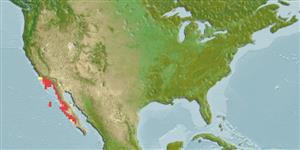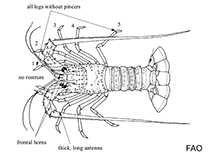Panulirus interruptus (Randall, 1840)
Mexican spiny loster| Native range | All suitable habitat | Point map | Year 2050 |

|
| This map was computer-generated and has not yet been reviewed. |
| Panulirus interruptus AquaMaps Data sources: GBIF OBIS |
Upload your photos
Google image | No image available for this species;
drawing shows typical species in Palinuridae.
Google image | No image available for this species;
drawing shows typical species in Palinuridae.
Classification / Names Common names | Synonyms | CoL | ITIS | WoRMS
Malacostraca | Decapoda | Palinuridae
Environment: milieu / climate zone / depth range / distribution range Ecology
Benthic; depth range 0 - 150 m (Ref. 94065). Subtropical; 35°N - 23°N, 121°W - 110°W (Ref. 108741)
Distribution Countries | FAO areas | Ecosystems | Occurrences | Introductions
Eastern Central Pacific: from San Luis Obispo Bay, California, USA, to Magdalena Bay, west coast of Baja California Sur, and along the west coast of the Gulf of California, to Carmen Island, Baja California Sur, Mexico.
Length at first maturity / Size / Weight / Age
Maturity: Lm ? range ? - ? cm Max length : 60.0 cm TL male/unsexed; (Ref. 4)
The Red Rock Lobster, Baja California, Mexico fishery of this species has been certified by the Marine Stewardship Council (http://www.msc.org/) as well-managed and sustainable (http://www.msc.org/html/content_1102.htm). Maximum depth from Refs. 104103, 122112. From the littoral zones (tidepools) to depths of about 65 m, being more frequent in deeper waters with rocky substrates (Ref. 4). Juveniles are abundant on exposed or semi-protected rock reefs densely covered with sea grasses and bushy algae (Ref. 104485). Surf grass Phyllospadix spp. may provide nursery habitat for them (Refs. 104485, 104486). Adults move into holes or crevices in the benthos (Ref. 106919). They primarily feed on crustaceans, mollusks and vegetal material (Ref. 104103). Adults consume algae, seagrasses, annelids, arthropods, mollusks, echinoderms, and bryozoans (Ref. 104485).
Life cycle and mating behavior Maturity | Reproduction | Spawning | Eggs | Fecundity | Larvae
Spawning is from May to August (Ref. 4).
Main reference
References | Coordinator | Collaborators
Holthuis, L.B. 1991. (Ref. 4)
IUCN Red List Status (Ref. 130435)
Least Concern (LC) ; Date assessed: 03 December 2009
CITES status (Ref. 108899)
Not Evaluated
CMS (Ref. 116361)
Not Evaluated
Threat to humans
Human uses
Fisheries: commercial
| FishSource |
Tools
More information
Internet sources
BHL | BOLD Systems | CISTI | DiscoverLife | FAO(Publication : search) | Fishipedia | GenBank (genome, nucleotide) | GloBI | Gomexsi | Google Books | Google Scholar | Google | PubMed | Tree of Life | Wikipedia (Go, Search) | Zoological Record
Estimates based on models
Preferred temperature
(Ref. 115969): 14.8 - 22.3, mean 18.4 (based on 12 cells).



